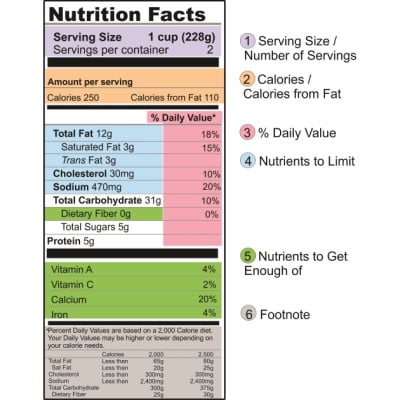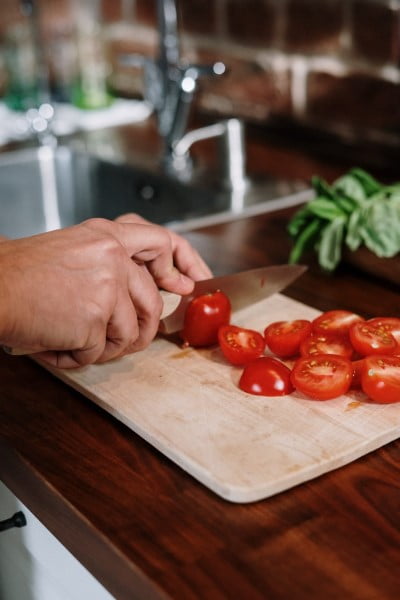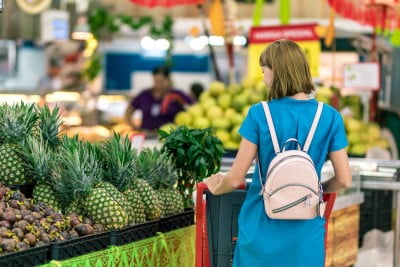Are you ready to make changes to your eating behavior? Here are some specific steps you can take to make smart food choices.
Whenever we buy food, the question that comes to our mind is “how to read the nutrition label?” The nutrition label includes excellent information, so if you’re not sure how to use it, it’s worth learning how. Reading nutrition labels is the most important step while making smart food choices.
The goal of the nutrition facts is to give enough nutrient-specific information about a product. So you can compare products and make an educated selection of which one best fits into your meal planning.
Reading food lables

- The first thing is the serving size and the servings per container. ( number 1 in picture above)
- The size of the serving influences the number of calories ( number 2)
- The nutrient amount listed in the labels ( number 4 and 5)
- The %daily value, or %DV ( number 3), % of the nutrient that is generally recommended in a standard 2,000 calorie diet (see the footnote at 6)
- %DV tells if a partiular food is a good source of the nutrients, and it allows comparisons between products.
Here’s is a good rule of thumb: If food provides a 5% daily value or less, it is a low source of that nutrient (e.g., low fat, low sodium). If food provides 20% daily value or higher, it is a high source of that nutrient (e.g., high fiber, high saturated fat)
You can use the nutrition facts label not only to limit those nutrients you want to cut back on (saturated fat, trans fat, and cholesterol). But also to increase those nutrients you want to eat in larger amounts (fibers, particular vitamins, and minerals)
Prepare food safely
When you prepare food, remember the 4C’s of food safety:
- CLEAN: Always wash your hands with warm soapy water for 20 seconds before handling food. When you’re done preparing food, clean counters and cutting boards with a solution of 15ml of bleach in 4L of water.
- COOK: Cook each item at a proper temperature- at least 75degree celsius or hotter.
- CHILL: Store the remaining food in covered containers and keep your fridge below 40 degrees Fahrenheit.
- CROSS CONTAMINATE:Don’t cross contaminate your food. Keep foods (especially raw meat and poultry) separated from each other.

Stay on a healthy path
Now you know how to buy foods and how to prepare them safely. Follow these things as well to stay on a healthy path:
- Cook at home
- Plan ahead when you go to buy grocery
- Have a few meatless meal each week
- Always try to have healtyh food options in your kitchen
- Eat proper serving sizes
- Eat slowly by properly chewing your food
- Stop eating when you are full. Don’t overeat just to satisfy your taste buds
- Avoid buying foods with claims like fat burner, fat mobilizer, energy enhancer, strength booster and many more.
- Stay away from breaded, battered, or fried foods. Instead, eat broiled, grilled, steamed, or sauteed foods.
Smart food choices to make

Proteins:
- Limit amount of red meat consumed
- Choose lean meats
- Eat a variety of fish and sea food cooked in a healthy way
- If you are a vegetarian, then add cottage cheese, tofu, lentils in your diet
Grains:
- Eat a variety of whole grains
- Choose brown rice and whole-wheat pasta and bread
Fruits & Veggies:
- Hit the salad bar first
- Avoid full-fat dressings and limit the amount used
- Evaluate how many fruits and veggies are on your tray
- Choose thin-crust pizza with veggies instead of meat and extra cheese
Dairy:
- Choose low-fat and fat-free dairy
Fat & Sweets:
- Always eat fat and sweets in moderation
- If you have a sweet-tooth then try healty sweet options like dark chocolate, dates, jaggery etc.
- Avoid foods in heavy cheese and cream sauces. Instead, switch to foods in a light broth or tomato sauce.
Smart snack choices to keep handy:
- Fresh fruits and veggies
- Canned fruits in light syrup
- Oat meal
- Granola bars
- Fiber-rich cereal
- Nuts
- Popcorn
- Canned tuna
- Peanut butter
- Low-sodium soups
- String cheese
- Low-fat milk
- Low-fat cottage cheese or yogurt
- Bottled water
Conclusion
Food is a very important part of a healthy & disease-free life. Buying food properly is the most crucial step. We should always make smart food choices when we buy them. Nutritional labels are an excellent way to choose nutritious food.
Today we discussed how to read the food labels and how can we prepare our food safely. We have also seen a lot of healthy snacking options which you can keep handy.
BEST OF LUCK!
